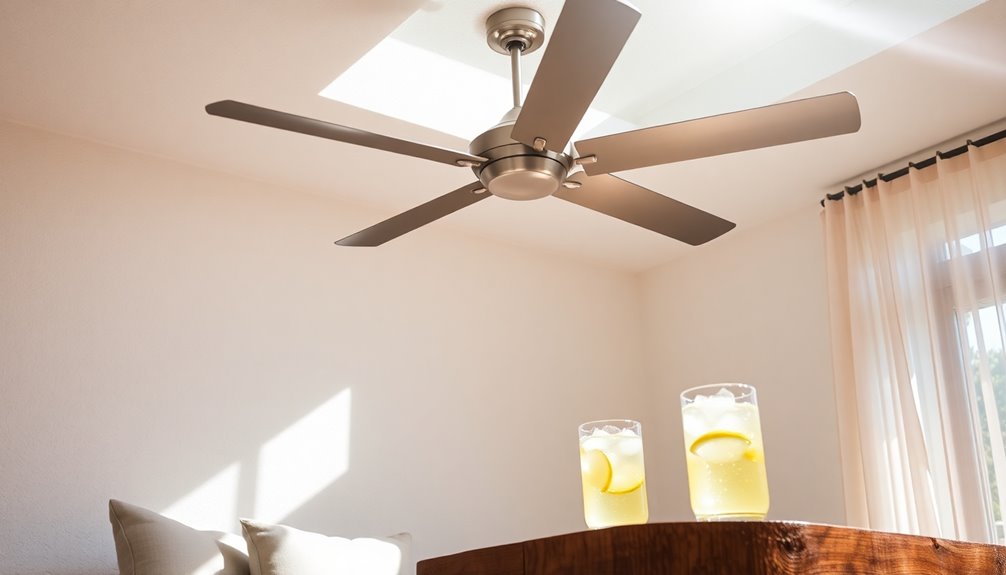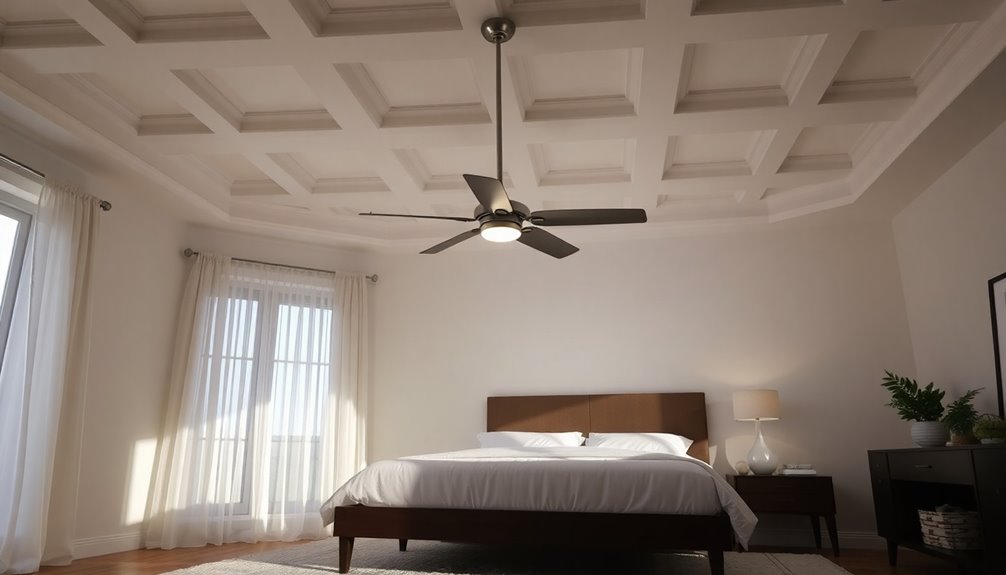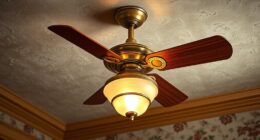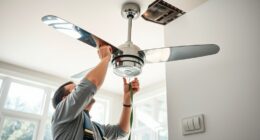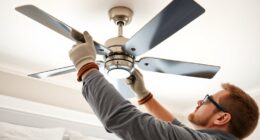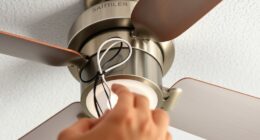Ceiling fans cool a room by spinning their angled blades to create a downdraft, which circulates air and enhances comfort. This moving air produces a wind chill effect, making you feel cooler—an 80°F room can feel like a revitalizing 72°F when the fan's on. To maximize efficiency, install the fan 7 to 9 feet above the floor. Using the fan in tandem with your air conditioning allows you to raise the thermostat setting, cutting energy costs considerably. Want to learn more about how to get the most out of your ceiling fan? Keep exploring!
Key Takeaways
- Ceiling fans create a downdraft by utilizing angled blades, improving air circulation in the room.
- The wind chill effect makes occupants feel cooler without changing the room temperature.
- Setting the fan to rotate counter-clockwise in summer maximizes the cooling breeze.
- Fans can enhance energy efficiency, allowing air conditioning thermostats to be set higher, saving on energy costs.
- Regular maintenance, such as cleaning blades, ensures optimal performance and cooling effectiveness.
Mechanics of Ceiling Fans

Have you ever wondered how ceiling fans can make a room feel cooler? Ceiling fans utilize angled blades that create a downdraft, pushing warm air down and promoting effective air circulation. As the fan rotates, it generates moving air, which enhances the wind chill effect. This means you'll feel cooler on your skin without actually lowering the room temperature.
For ideal cooling, ceiling fans should be installed at a height of 7-9 feet above the floor and around 10-12 inches below the ceiling. This setup maximizes their cooling capabilities.
It's important to remember that ceiling fans are designed to cool people rather than the air itself. If you're in the room, the moving air will make you feel considerably cooler—an 80°F room can feel like 72°F with a well-placed fan.
This wind chill effect is crucial for energy efficiency, as it allows you to rely less on air conditioning. By creating a breeze, ceiling fans enhance your comfort level, making your space feel invigorating while saving on energy costs.
Benefits of Using Ceiling Fans

Ceiling fans offer a range of benefits beyond just cooling your space. They create a wind chill effect by circulating air, making you feel cooler on your skin without actually lowering the room temperature. This enhancement of comfort is particularly valuable in the summer months.
When you run ceiling fans alongside air conditioning, you can increase your thermostat settings by up to 4°F while still feeling comfortable, which can lead to energy savings of 30-40%.
One of the standout advantages of ceiling fans is their energy efficiency. They consume about 1% of the energy used by air conditioning units, considerably reducing your cooling costs.
By using ceiling fans regularly, you can also extend the lifespan of your HVAC system, as they help reduce its workload and contribute to long-term energy efficiency.
Moreover, ceiling fans are versatile enough to be used year-round. In summer, they provide a revitalizing breeze, while in winter, they help distribute warm air, enhancing overall home comfort.
Ceiling Fans and Air Conditioning

Using a ceiling fan in conjunction with your air conditioning can greatly enhance your indoor comfort while also saving on energy costs.
While ceiling fans don't actually lower room temperature, they create a wind chill effect that makes you feel cooler. This allows you to raise your thermostat setting by up to 4°F without sacrificing comfort, leading to significant energy savings.
Ceiling fans consume about 1% of the energy used by air conditioners, making them a cost-effective solution to improve indoor comfort. Additionally, when considering overall household energy efficiency, using a ceiling fan can complement eco-friendly toilets that help reduce water consumption.
When you run a ceiling fan while your air conditioning is on, you can reduce reliance on your AC unit, which can decrease its workload and potentially extend its lifespan.
To maximize cooling efficiency, set your ceiling fan to rotate in a counterclockwise direction during the summer months. This pushes cool air down and promotes better air circulation throughout the room.
Proper Usage Tips

To make the most of your ceiling fan, start by ensuring it's set to rotate counter-clockwise during the summer months. This setting creates a downdraft that enhances air circulation and generates a cooling breeze, making your room feel cooler.
For ideal airflow, use the medium speed setting; it strikes a balance between energy consumption and cooling effectiveness for most room sizes.
Remember, ceiling fans cool people, not rooms, so turn off the fan in unoccupied spaces to conserve energy. When paired with air conditioning, ceiling fans can help you raise your thermostat settings by up to 4°F without sacrificing comfort, leading to significant energy savings.
Regular cleaning is another essential aspect of proper usage tips. Dust buildup on the fan blades can hinder airflow and reduce the fan's cooling efficiency.
Make it a habit to clean your ceiling fan monthly to maintain ideal performance.
Energy Savings Potential

When you think about cooling your home, ceiling fans offer a surprisingly cost-effective solution. They consume only about 1% of the energy used by air conditioning systems, making them an excellent option for energy savings. By using ceiling fans, you can comfortably raise your air conditioning thermostat settings by up to 4°F, potentially saving you 12% on cooling costs.
Combining ceiling fans with your AC not only reduces energy costs but also lowers the runtime of your HVAC system, extending its lifespan. Energy Star certified ceiling fans can improve your energy efficiency by up to 60%, providing even more savings compared to standard models.
Here's a quick overview of the potential savings:
| Feature | Impact on Energy Costs | Benefit |
|---|---|---|
| Ceiling Fans | 1% of AC energy usage | Significant cost savings |
| Thermostat Settings | Raise by 4°F | Save money on AC bills |
| Energy Star Certified Fans | Up to 60% efficiency | Increased energy savings |
Installation Considerations

When installing a ceiling fan, it's essential to take into account the room's ceiling height to guarantee safety and ideal airflow.
You'll want the blades positioned correctly for maximum efficiency, ideally 8 to 9 inches from the ceiling.
Following proper installation practices will help you get the most out of your fan, enhancing its cooling benefits.
Ceiling Height Requirements
Installing a ceiling fan requires careful consideration of ceiling height to assure peak performance and comfort. To guarantee ideal airflow and air circulation, keep these guidelines in mind:
- Minimum Ceiling Height: Install ceiling fans in rooms with a minimum ceiling height of 8 feet. This allows the fan blades to operate effectively.
- Blade Positioning: Position the fan blades 8-9 feet above the floor and 10-12 inches below the ceiling to maximize performance.
- Use of Downrods: For ceilings higher than 9 feet, use downrods to achieve the recommended height for proper airflow.
- Blade Diameter: Select fans with a blade diameter of 36-44 inches for spaces up to 225 square feet. Larger rooms may need fans with a diameter of 52 inches or more.
Proper placement of your ceiling fan in the center of the room enhances air circulation efficiency and overall room comfort.
When the air moves freely, you'll feel the cooling effects more effectively, making your space comfortable during warmer months.
Optimal Blade Placement
To achieve ideal cooling and airflow, you should install ceiling fans at a height of 7 to 9 feet above the floor. This installation height guarantees effective airflow without obstruction.
Position the fan blades 10 to 12 inches below the ceiling to maximize air circulation and maintain efficient operation. The ideal placement for ceiling fans is in the center of the room, promoting even air distribution and enhancing cooling effectiveness.
When selecting your ceiling fan, consider the blade diameter. Fans with a diameter of 36 to 44 inches work well in rooms up to 225 square feet, while larger spaces require fans with a diameter of 52 inches or more for adequate airflow.
Proper installation also involves maintaining a distance of at least 18 inches from walls, which enhances air movement and cooling efficiency.
Installation Best Practices
Proper installation of ceiling fans is vital for maximizing their cooling effectiveness and guaranteeing safety. To achieve ideal airflow and air circulation, consider the following best practices:
- Installation Height: Hang your ceiling fan 7-9 feet above the floor, confirming it's 10-12 inches below the ceiling for maximum efficiency. This height promotes effective air circulation throughout the room.
- Fan Size: Choose a fan size appropriate for your room size. For spaces up to 225 square feet, a fan with a diameter of 36-44 inches suffices. Larger rooms may need fans of 52 inches or more to maintain airflow.
- Proper Placement: Position your fan at the center of the room. This location enhances airflow effectiveness and guarantees even air distribution across the space.
- Fan Blades Clearance: Confirm fan blades are at least 18 inches away from the nearest wall. This distance is vital for effective air circulation and peak fan performance.
Additionally, selecting a ceiling fan with a high CFM rating ensures optimal airflow, enhancing the cooling experience in your room.
Frequently Asked Questions
Will a Ceiling Fan Cool Down a Room?
A ceiling fan won't actually cool down a room, but it can make you feel cooler.
By circulating air, it creates a wind chill effect that helps sweat evaporate from your skin, making it feel up to 8°F cooler.
You can set your thermostat higher without sacrificing comfort.
Just remember to turn it off when you leave the room, as it's only effective when you're there to enjoy the breeze.
Which Way Should a Ceiling Fan Turn to Cool the Room?
Did you know that a ceiling fan can make a room feel up to 8°F cooler?
To achieve this effect, you should set your ceiling fan to rotate counterclockwise in summer. This direction creates a downdraft, pushing cool air down and enhancing the wind chill effect.
You'll stay more comfortable without lowering your thermostat.
Remember to switch it to clockwise in winter to circulate warm air effectively!
How Effective Are Ceiling Fans for Cooling?
Ceiling fans are quite effective for cooling, especially during warm months.
You'll feel a noticeable difference in comfort as the fan creates a wind chill effect, making the air feel cooler on your skin. By running it counterclockwise, you can push cool air down, enhancing airflow.
Plus, they use much less energy than air conditioners, allowing you to save on utility bills while enjoying a pleasant environment.
Just remember to turn it off in unoccupied rooms!
How Much Does a Ceiling Fan Cool a Room?
Imagine standing in a gentle breeze on a hot summer day. That's what a ceiling fan does—it creates a wind chill effect that makes you feel cooler.
While it doesn't actually lower the room temperature, it can make an 80°F room feel like 72°F by circulating air.
Running your fan efficiently not only enhances your comfort but can also help you raise your thermostat setting, saving you money on cooling costs.
Conclusion
In the grand symphony of home comfort, ceiling fans are the unsung heroes, orchestrating a delightful breeze that feels like a cool mountain gale. By simply flipping a switch, you summon a rejuvenating whirlwind that makes summer heat a mere whisper. Pairing them with your air conditioning is like having a secret weapon against sweltering days. So, embrace the magic of ceiling fans; they're not just an accessory, they're the key to transforming your room into an oasis of cool bliss!
